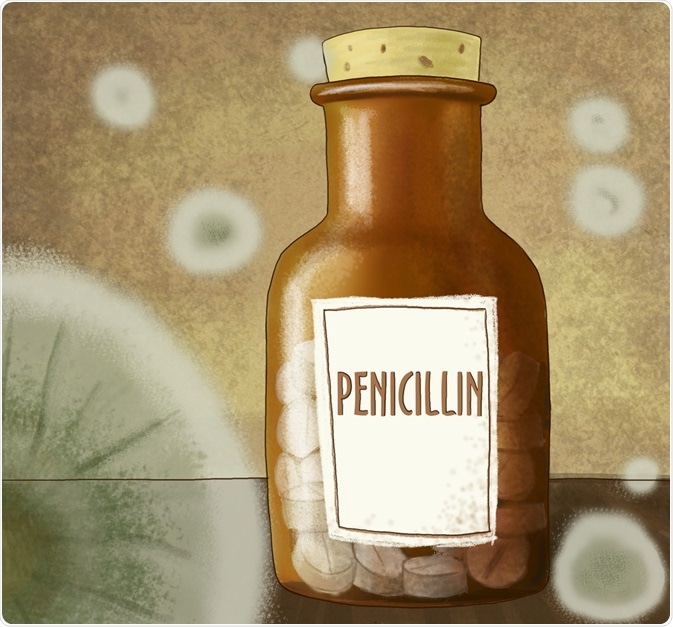Penicillin is a widely used antibiotic prescribed to treat staphylococci and streptococci bacterial infections. Penicillin belongs to the beta-lactam family of antibiotics, the members of which use a similar mechanism of action to inhibit bacterial cell growth that eventually kills the bacteria.

Image Credit: Melinda Raduly / Shutterstock.com
The structure of bacteria
Bacteria cells are surrounded by a protective envelope called the cell wall. One of the primary components of the bacterial cell wall is peptidoglycan, a structural macromolecule with a net-like composition that provides rigidity and support to the outer cell wall.
In order to form the cell wall, a single peptidoglycan chain is cross-linked to other peptidoglycan chains through the action of the enzyme DD-transpeptidase, which is also known as a penicillin-binding protein (PBP). Throughout a bacterial lifecycle, the cell wall, and thus the peptidoglycan cross-links, is continuously remodeled in order to accommodate for repeated cycles of cell growth and replication.
Penicillin's mechanism of action
Penicillin and other antibiotics in the beta-lactam family contain a characteristic four-membered beta-lactam ring. Penicillin kills bacteria through binding of the beta-lactam ring to DD-transpeptidase, inhibiting its cross-linking activity and preventing new cell wall formation. Without a cell wall, a bacterial cell is vulnerable to outside water and molecular pressures, which causes the cell to quickly die. Since human cells do not contain a cell wall, penicillin treatment results in bacterial cell death without affecting human cells.
Gram-positive bacteria have thick cell walls containing high levels of peptidoglycan, while gram-negative bacteria are characterized by thinner cell walls with low levels of peptidoglycan. The cell walls of gram-negative bacteria are surrounded by a lipopolysaccharide (LPS) layer that prevents antibiotic entry into the cell. Therefore, penicillin is most effective against gram-positive bacteria where DD-transpeptidase activity is highest.
Resistance
Bacteria reproduce quickly and are prone to genetic mutations when growing in the presence of environmental pressures, such as an antibiotic. Over time, genetic mutations that provide a survival advantage may arise in the bacterial population, allowing bacteria to continue to grow and multiply in the presence of antibiotic. This leads to the creation of a resistant strain, which can only be killed through the use of alternative and stronger antibiotics.
The potential for antibiotic resistance increases through repeated or improper use of an antibiotic. Bacterial strains can become resistant to more than one antibiotic, leading to the creation of “superbugs” that are extremely difficult to treat medically.

Image Credit: Lightspring / Shutterstock.com
Bacteria generate antibiotic resistance through a number of mechanisms. Some bacteria can become resistant to penicillin by producing beta-lactamase, which is a bacterial enzyme that destroys the beta-lactam ring of penicillin and makes it ineffective.
One common example is Staphylococcus aureus, which produces high levels of beta-lactamase and causes infections in the blood, skin, or lungs. Most Staphylococcus aureus strains are now resistant to penicillin. In response, scientists have developed a synthetic form of penicillin that is resistant to beta-lactamase, termed penicillinase-resistant penicillins or second-generation penicillins. These include dicloxacillin, oxacillin, nafcillin, and methicillin.
Soon after development, researchers quickly identified Staphylococcus aureus strains resistant to methicillin, termed methicillin-resistant Staphylococcus aureus (MRSA). MRSA uses a second resistance method to overcome methicillin, namely by upregulating a low-affinity form of penicillin-binding protein that does not bind the antibiotic and whose activity is not inhibited. To date, MRSA has demonstrated blanket resistance to all beta-lactam antibiotics and is an extremely serious health risk.
The threat to public health
In 2014, the World Health Organization reported that antibiotic resistance is a worldwide threat to public health. In areas around the world, disease-causing bacteria are already resistant to all initial forms of antibiotics and are quickly developing resistance mechanisms to treatments of last resort.
Some antibiotic-resistant bacteria are highly contagious and can quickly spread throughout a family or community, creating a serious public health risk.
As bacteria continue to gain resistance to some of the strongest antibiotics available, pharmaceutical development of new antibiotic agents is in decline. This is due to several reasons, including low profitability due to short treatment cycles, lack of new therapeutic targets or strategies for killing bacterial cells, and low tolerability in the medical community for side effects.
References
Further Reading